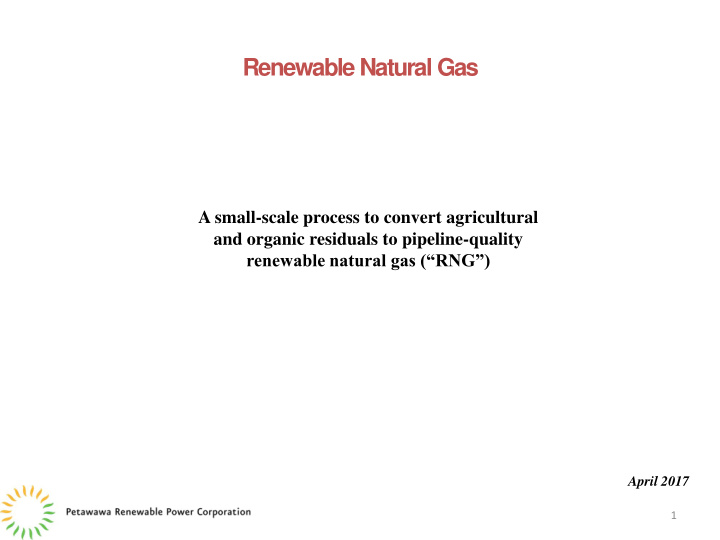



Renewable Natural Gas A small-scale process to convert agricultural and organic residuals to pipeline-quality renewable natural gas (“RNG”) April 2017 1
Renewable Natural Gas Raw Materials: Organic waste from food processing facilities, grocery stores, food distribution companies, bakeries, confectionary processing facilities, dairies and facilities that process dairy products, fruit and vegetable processing facilities, cereal and grain processing facilities, oil seed processing facilities, snack food processing facilities, snack food manufacturing facilities, breweries and other spent grains, wineries and beverage manufacturing facilities, fruit and vegetable packing facilities, milling facilities, DAF material from water and waste water treatment plants, kitchen organic material, livestock, aquaculture, and paunch manure, glycerol and by- products from ethanol, biodiesel, breweries, and distillery plants, FOG, crop residuals (i.e., corn silage), herbaceous plant material from greenhouse, nurseries, garden centers & flower shops. 2
Example Vermont 3
Southern Ontario Examples Chatsworth, Grey County “We offer an entirely new future for organic waste management. No odour. No even any odour complaints. Not one. Year after year. No one has ever done this before, at large scale, in an urban setting. We have permanently changed the conversation about odour. It no longer needs to be accepted or managed--with us, there is no odour. ” Grimsby, Niagara Elmira, Waterloo 4
Process Summary • Biomethanation is an enclosed fermentation process. • Agricultural residuals and food reject materials are slowly fermented in an enclosed vessel. • Examples: potato and fruit cull materials / silage / stover / manures, food by-products, etc. • The enclosed fermentation captures methane and carbon dioxide. • The gases are purified, and the pure methane is compressed and injected into the nearby Enbridge Gas pipeline. 5
Process Chemistry 6
Project Specifications Footprint: 2 hectares Building footprint: < 500 m2 Zoning: Industrial Employment: 2-4 persons Capex: $5-8 million Raw Materials: approx. 50,000 tonnes/year (5 truckload/day) Utilities: Natural Gas / Electrical / Water (non-potable) 7
Engineering & Operations & An Ontario Municipal Utility Corporation 8
Renewable Natural Gas Production of : 2,400,000 M3 RNG/year (91,000 GJ) Equivalent to energy use in : 900 households 9
The Opportunity – Renewable Natural Gas (RNG) • Environmentally Positive – Net Neutral if 100% RNG Approximately six per cent of • Safe Ontario’s total greenhouse gas emissions come from the residual • Affordable materials sector and 90 per cent of • Convenient this is from landfilled materials. • Proven This gas is primarily methane generated by decomposing organic materials, which has a global Substituting only 6% of traditional natural gas warming potential 25 times greater represents approximately 14 TWh Equivalent – than carbon dioxide (CO2). enough energy to meet the electrical needs of approximately 1.5 million homes for a year If Ontario is to seriously tackle climate change, including making progress on the Climate Change Action Plan, preventing greenhouse gas emissions from landfill must be a priority. 10
Utilities Working Together Enabling a Low Carbon Future with Gas and Electric Utilities 11
Injecting RNG into Gas Network Existing Gas Line Being Assessed to Accept RNG from Petawawa Power Corp X 12
Digestate The process liquids after fermentation are qualified as fertilizer and delivered back to the farms from whence raw material is sourced – a closed loop. NPK present in the raw feedstock remains in the digestate. 13
Emissions Sound: Negligible Water: None Air/Odour: Negligible. MOE Emission Limits respected by way of: Good Housekeeping / Carbon Filters / Biofilter. Anaerobic digestion reduces odours by a factor of 10x compared to composting. Digestate: Fertilizer grade material Enhances fertiliser value because: • Pathogens killed; and • Odour reduced – organic substances removed and captured. 14
Odour Emissions Odour that is produced by the process, can and will be contained. The ventilated air is filtered to remove any odour, before it is released through the ventilation system. Odour Management: • State-of Art filtration and ventilation system imposed by MOECC; • Negative pressure within building directs air to filtration; • Good Housekeeping – keeping site clean; • Continuous monitoring required; • Odour-Tight Reception Tanks & Gas-Tight Operation; • No open storage of materials; • All truck movements in enclosed vehicles. 15
Odour Emissions - example Odour Assessment Clapham Lodge Anaerobic Digestion Plant REC Report: 33511r2 Issued: 10th July 2013 Blue contours = less than 5% of the threshold odour value 16
Environment 1. Odour contained within site; 2. Small footprint; 3. Little traffic; 4. Closed water loop; 5. Consistent, Complementary and Supportive use to existing facilities in Eco-Park; 6. Fossil-Fuel-Free Energy: A. Supporting Federal Clean Fuel Standards; B. Supporting Ontario’s Waste Free Act; C. Supporting Enbridge to “Green the Grid”; D. Capturing high greenhouse-gas methane emissions. 7. Assists with Municipal and County recycling requirements. 8. 17
Site Considerations A less desirable location in the Eco-Park is acceptable, close to the sewage lagoons. 18
Next Steps 1. Open House; 2. Council Agreement; 3. Permitting / Engineering, Including: • Odour / Noise / Traffic studies and reports; • Zoning Approval (public process); • Grand River Conservation Authority approval; • Ministry of the Environment and Climate Change Approval (public process). 4. Construction; 5. Operation 2018/2019. 19
Recommend
More recommend